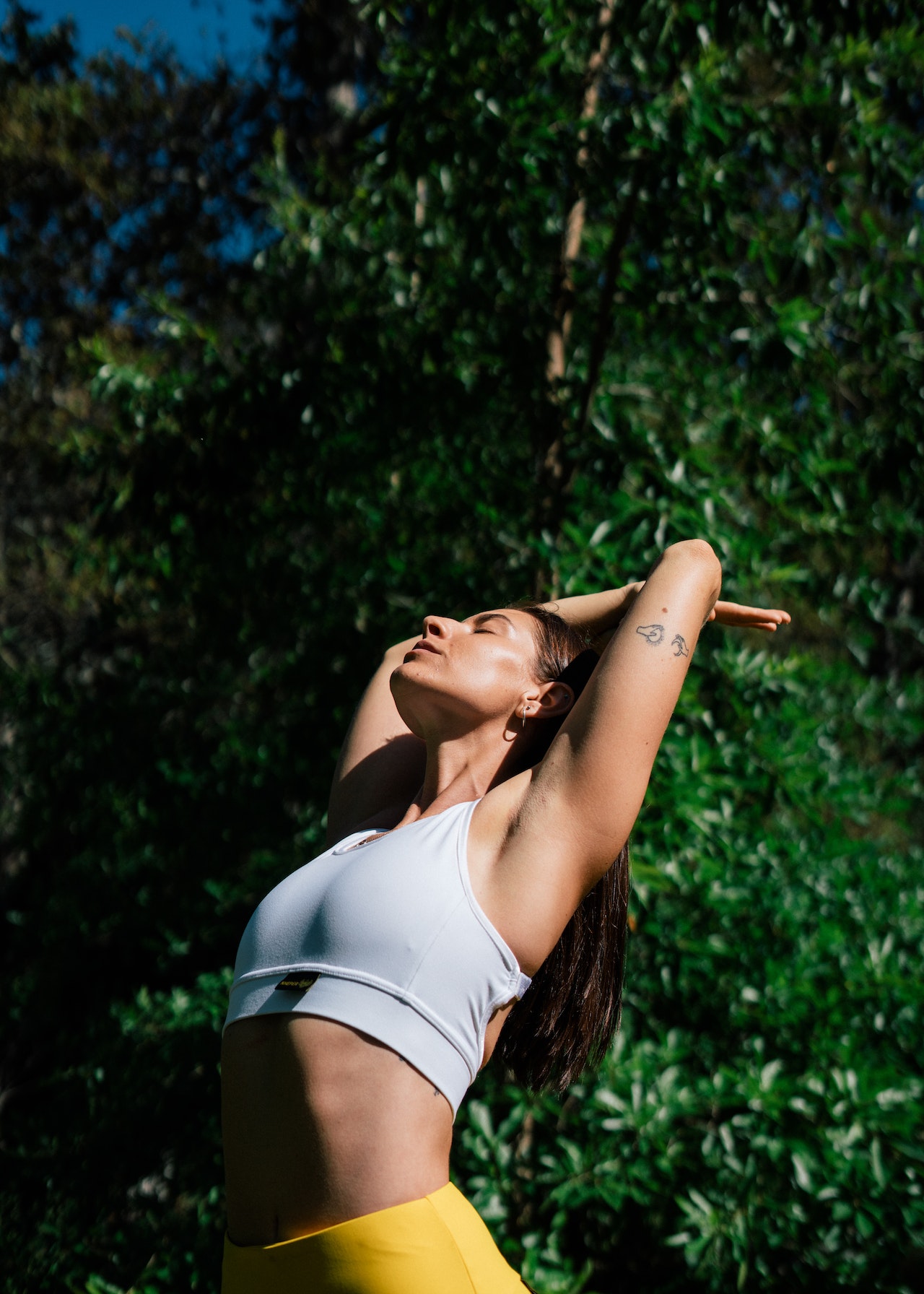My teeth clench as I slam them together to finish the set of bum exercises, as instructed.
My eyes glance around the room, with increasing urgency, trying to find a clock. My bum is now cramping, the unpleasant crick and stitch a burning irritant I tense against. I feel the sensations of annoyance ripping through my shoulders as my upper body tightens with the refrain of “last eight, now seven, six…keep pushing!”
“How much longer do I have to do this shit,” I think to myself.
The fitness instructor lets out a “wooo!” to denote that we are finished.
And I note that I still can’t find the fucking clock.
The pursuit of exercise most frequently correlates to a focus on wardrobing, choreographed routines, and/or instructor cueing that’s dedicated to reminders about appearance and focused on achievement.
I was immersed in the thick of it. And hanging out in a shame trigger.
A tear rolled down my cheek.
“This is bringing down my academic average,” I muttered as I wiped it away, embarrassed to be crying in my physical education teacher’s office. I was 14 and PE was a mandatory element of high school graduation.
Our grades were a combination of written tests and skills tests. While I could ace the exam on where I was supposed to be in the volleyball game, I failed to actually be able to execute it.
Through absolutely no fault of the teacher, fitness skills needed to be graded. The focus was on team sports, most often involving a ball, a physical literacy skill that I not only didn’t have back then but still do not possess today.
Breaking sports down into competitions, teams, skills, drills, and grades sent a clear message to me that I was hopelessly bad at it.
I would get a weeks-long pit in my stomach whenever we had a unit in gymnastics, basketball, or volleyball. I was bad at badminton, baseball, and the nationally mandated fitness tests.
At 12 years old, in grade seven, I was informed that I scored in the bottom 1 percent in flexibility in the nation.
Red faced, breathless, and sweaty, I poured 120 percent of my effort into the running component of that test and scored a decent-enough level that my teacher told me “this is what could happen if you applied yourself.”
I wanted to not feel burning shame about my body, so that’s exactly what I did as an adult.
Two years after high school, I found myself in a chain gym in Toronto, with mirrors at one end of the room and an instructor in skin-tight clothing making notes in a booklet about my “routine.”
She corrected my “form” and I trusted her more than I trusted myself. I found my eyes darting around the room, comparing myself to others, landing on the most idealized body in the room, and checking my flawed and shameful body against hers.
I didn’t feel good enough.
I subscribed to Shape magazine and saved the recipe-sized cutout cards with fitness tips written by experts.
And I quickly set out to “apply myself” to hide my body shame. The more I could follow instructions, the more I could fit in, be like everyone else, and look right.
I gritted my teeth in those classes, pushed weights with trainers, tensed my neck, and followed coercive fitness culture cues such as:
“You got this.” Actually, I felt socially shamed into continuing, even when I hated what I was doing, was experiencing muscle cramps, or was getting injured in the process.
“Three more, and two, and one.” The countdowns made me disconnect from my sensations and focus on getting outside the experience of my body.
“If you need to modify the exercise, let me know.” I didn’t want to stand out, be lesser, or identify myself as the person who “couldn’t apply myself,” so I refused to do what I considered “lesser” and bore down through whatever the more socially acceptable option was.
“Lift that booty.” Body shame was my jam, so even though I rarely felt anything in my bum, I did what I was told.
“Push through.” I was right back in junior high with the value of pushing, forcing, jamming, and ramming myself through discomfort, pain, and stuff I hated. I didn’t want anyone to see weakness or failure.
Years passed and I softened. I discovered pilates, Yamuna Body Rolling, and yin yoga: movement modalities that were more aligned with my body and its capacities. I learned about my skeletal variation in yin, functions movement with pilates, and interoception and space with Yamuna.
These sensations in no way resembled pushing myself and the more subtle movements created physical changes that volleyball never had.
I discovered Kristin Neff’s work on self-compassion, which is harder for me to execute than any physical exercise.
I became an instructor and opened a practice as a movement specialist to work with other people who struggled as I had.
And I discovered how much shame, pain, and trauma are related to movement. I became interested in how embedded fitness culture impacted my body and experience when exercising and moving. And how it informed the choices I was making for myself and as a teacher.
I studied trauma modalities including Gabor Maté’s Compassionate Inquiry and The Trauma Centre’s Trauma Sensitive Yoga.
I found myself on the mat in tears during a short Trauma Sensitive Yoga practice, a modality of facilitating a movement experience that includes non-coercion, relationship, making choices, and creating rhythms. I had never experienced what choice felt like in my body.
I stayed out of gyms for years as I got to know my own body differently, on my terms. I could move toward or away from intensity in ways that met the needs of my nervous system, not the social pressure around me. I could work in my own mirror-free spaces where my focus was feeling the body rather than seeing it.
I could make my own choices and stay focused on the present moment experience rather than counting down or gritting my teeth in tension against something I didn’t even enjoy.
I slowly healed some of my shame and trauma around my body.
When I re-experienced fitness classes again, the experience was jarring. Just like my PE teacher, the rules of the culture set the tone and expectations made me perceive myself to be flawed, wrong, fat, shameful, clumsy, and a failure. Those are the motivating forces in these environments.
I noticed that I was triggered—but this time, I could see it differently.
Movement is inherent to my body. It’s not reasonable that I will feel joy in every step or undulation.
But my observations in the fitness studio seemed, now, like less of a personal individual failure and more like a broad-scale call for social reform of fitness culture.
Why are we making people feel bad in pursuit of an idealized body form that few can achieve or maintain? Why are we asking people to push or mindlessly counting down numbers to help people numb out? Why are we focusing on mirrors and maximizing pain in order to be socially acceptable?
What could a new world order of fitness and movement entail?
We can ask for accountability of our instructors to be trauma informed.
We can seek facilities without mirrors.
We can stop booking classes where the focus is following the instructions and ignoring our inner cues.
We can demand that modifications are not seen as “less” but simply different because every body in the room is different.
We can seek experiences of safety rather than shame.
We can require that our instructors be our facilitators and peers rather than a person we feel fear or shame around.
We can stop gritting our teeth and pushing through, and begin to require our bodies to be spoken to with compassion.
Healing our shame and trauma isn’t an intellectual pursuit, it’s a somatic one.
We cannot do the work at a therapist’s office then turn around and go to a spin class where we are coerced, shamed, and forced.
We need to unclench the teeth that fitness culture has clamped around our bodies.
~
Please consider Boosting our authors’ articles in their first week to help them win Elephant’s Ecosystem so they can get paid and write more.
~


 Share on bsky
Share on bsky





Read 8 comments and reply